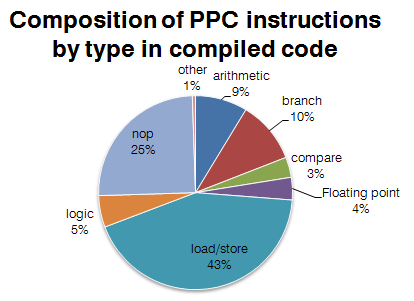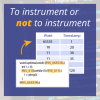We've been looking recently at some object code from an Ada compiler for the PowerPC e500v2 core. As part of this, we examined the distribution of instruction mnemonics in the code generated by this particular use of the compiler on a suite of example programs.
The split by type of instruction is roughly as follows:

Interestingly, there aren't as many compare operations as we might otherwise expect. This is because xor tends to be used for this instead.
As is usually the case, there are some opcodes that are favoured and some that are never used, and as is also usually the case, the interesting stuff is in between.
Below is a list of instructions that were only used once in the generated output (out of over 100k instructions).
- lhzx (Load Half Word and Zero Indexed)
- This came up on the first assignment in a loop assigning record components in an array of records.
- nand
- We saw this on the one instance of
v := not( a and b )where the operation was on a modular type with 32 bits of storage. - evxor (Vector XOR)
- This was used as a 64-bit "load immediate zero" by performing
evxor %r10,%r10,%r10. In this case the registerr10was then used for initialising an array of 5 bytes. - rlwinm. (Rotate Left Word Immediate, then AND with Mask)
- This was used in a binary-search of different case-branches for an enumeration type. The line
rlwinm. %r9,%r3,0,11,16was used, which works if the decision to be made happens to be something that can be decided by masking bits. - addze. (Add to Zero Extended)
- This was a puzzler, it turns out it was from doing an integer division that needed to be rounded, and then using that for the Ada "mod" operator. The division was implemented as a shift, so the rounding compensation can be picked up from the carry flag using
addze; the value needs to be tested to implement "mod" so the flags can be set directly from that add. - efsnabs (Floating point negative absolute value)
- Normally this compiler tries to rearrange expressions to a simplified form, and this often results in a "-abs" operation getting split up. This one time, it happened to be in a place where the compiler couldn't rearrange things as much, so it opted for a "negative abs" instruction.
- adde. (Add Extended)
- A curious combination of events here, where we are explicitly testing for membership of a range of values, but the range is all negative values going up to -1; the compiler spotted that it would have done an
addze.on a register that's already zero in this case, and switched to anadde.instruction instead.

 Rapita System Announces New Distribution Partnership with COONTEC
Rapita System Announces New Distribution Partnership with COONTEC
 Rapita partners with Asterios Technologies to deliver solutions in multicore certification
Rapita partners with Asterios Technologies to deliver solutions in multicore certification
 SAIF Autonomy to use RVS to verify their groundbreaking AI platform
SAIF Autonomy to use RVS to verify their groundbreaking AI platform
 How to measure stack usage through stack painting with RapiTest
How to measure stack usage through stack painting with RapiTest
 What does AMACC Rev B mean for multicore certification?
What does AMACC Rev B mean for multicore certification?
 How emulation can reduce avionics verification costs: Sim68020
How emulation can reduce avionics verification costs: Sim68020
 Multicore timing analysis: to instrument or not to instrument
Multicore timing analysis: to instrument or not to instrument
 How to achieve multicore DO-178C certification with Rapita Systems
How to achieve multicore DO-178C certification with Rapita Systems
 How to achieve DO-178C certification with Rapita Systems
How to achieve DO-178C certification with Rapita Systems
 Certifying Unmanned Aircraft Systems
Certifying Unmanned Aircraft Systems
 DO-278A Guidance: Introduction to RTCA DO-278 approval
DO-278A Guidance: Introduction to RTCA DO-278 approval
 DO-178C Multicore In-person Training (Toulouse)
DO-178C Multicore In-person Training (Toulouse)
 HISC 2025
HISC 2025















